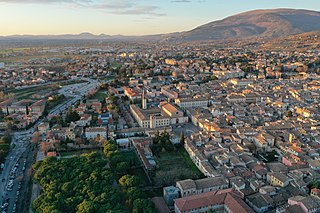
Rimini is a city in the Emilia-Romagna region of Northern Italy.
The Silver Medal of Military Valor is an Italian medal for gallantry.

A comune is an administrative division of Italy, roughly equivalent to a township or municipality. It is the third-level administrative division of Italy, after regions and provinces. The comune can also have the title of città.

Foligno is an ancient town of Italy in the province of Perugia in east central Umbria, on the Topino river where it leaves the Apennines and enters the wide plain of the Clitunno river system. It is located 40 kilometres south-east of Perugia, 10 km (6 mi) north-north-west of Trevi and 6 km (4 mi) south of Spello.

Rimini and San Marino "Federico Fellini" International Airport, formerly Rimini Miramare Airport, and more simply known as Rimini Airport or Fellini Airport, is an international airport located in Rimini, in the region of Emilia-Romagna, northern Italy.

Riccione is a comune in the Province of Rimini, Emilia-Romagna, northern Italy.

The 12th Alpini Regiment is an inactive regiment of the Italian Army's mountain infantry speciality, the Alpini, which distinguished itself in combat during World War I and World War II. First formed on 15 February 1936 to command the units of the 7th Alpini Regiment, which remained in Italy and did not participate in the Second Italo-Ethiopian War, the regiment was disbanded on 1 July 1937 upon the 7th Alpini Regiment's return to Italy. Formed again on 8 August 1992 as unit of the Alpine Brigade "Cadore", the regiment was inactivated on 31 January 1997.

The 15th Alpini Regiment is an inactive regiment of the Italian Army's mountain infantry speciality, the Alpini, which distinguished itself in combat during World War I and World War II.
The Gold Medal of Military Valor is an Italian medal established on 21 May 1793 by King Victor Amadeus III of Sardinia for deeds of outstanding gallantry in war by junior officers and soldiers.
The Bronze Medal of Military Valor is an Italian medal for gallantry.
The Medal of Military Valor is an Italian medal, originally established as a Sardinian award. It is awarded to military personnel, units above the level of company, and civilians for exceptional valor in the face of the enemy.

Francesco Mancini was an Italian painter whose works are known between 1719 and 1756. He was the pupil of Carlo Cignani.

Enrico Martini Mondovì, 29 January 1911 – Turkey, 19 September 1976) was an Italian soldier and partisan, an Alpini Major, founder of the 1 Group Alpine Divisions in the Italian Resistance, and a recipient of the Gold Medal of Military Valor.

The Italian honours system is a means to reward achievements or service to the Italian Republic, formerly the Kingdom of Italy, including the Italian Social Republic.
Luigi Ferraro was an officer of the Royal Italian Navy and pioneer of Italian submarine warfare, most notable for his service with the commando frogman unit Decima Flottiglia MAS. In 1943 in Turkey he attacked four ships carrying chromium ore. He was decorated with the gold medal for military valor for having sunk three enemy ships alone.

Valentino Babini was an Italian general during World War II. He was one Italy's foremost pioneers in tank warfare and among the most important tank commanders of the Royal Italian Army during the interwar period and the early stages of World War II; in 1940 he coined the motto of Italy's tank troops, Ferrea mole, ferreo cuore.

Corrado Mazzoni was an Italian Lieutenant of World War I. He was an officer within the 67th Infantry Regiment and took part in the Tenth Battle of the Isonzo and the Eleventh Battle of the Isonzo before succumbing to wounds during a siege at Veliki Hrib. He was a posthumous recipient of the Gold Medal of Military Valour for his service during the war.

The 92nd Infantry Regiment "Basilicata" is an inactive unit of the Italian Army last based in Foligno. The regiment is named for the region of Basilicata and part of the Italian Army's infantry arm.

The Fragheto massacre was the massacre of 30 Italian civilians and 15 partisans in Fragheto, a frazione of Casteldelci in central-northern Italy, on 7 April 1944, during World War II, by soldiers of the German 356th Infantry Division. After partisans belonging to the Eighth Garibaldi Brigade ambushed troops approaching the hamlet, fourteen soldiers of the Sturmbattaillon OB Sudwest conducted house-to-house searches and summarily killed civilians. Representing 40% of the hamlet's population, many of the victims were elderly people, women, or children. A further seven partisans and one civilian were shot the next day at Ponte Carrattoni, at the confluence of the Senatello and Marecchia.














